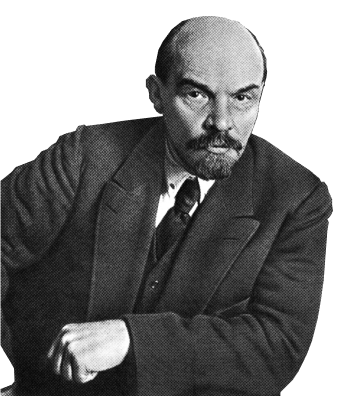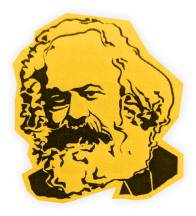The role played by the United States in the coup has been the subject of a heated debate. It is clear that when Obama arrived at the White House he wanted to adopt a different approach to Latin America than Bush’s. The policy of Bush of waving the stick, that is the belligerent harassment of the growing revolutionary movement in the continent, including the organisation and support for attempted coups in Venezuela and Bolivia, and in general the direct destabilisation of governments considered to be “dangerous”, had not given good results and furthermore had put the US on the defensive and isolated its position in the continent.
From Obama’s point of view, it was time to use the carrot. The aims of US imperialism remain the same, the domination of the continent as a source of raw materials, a market for its products and an area of geo-strategic interest. That has not changed. However, Obama wanted to pursue the same aims with different methods. Thus we saw how at the Summit of the Americas in Trinidad in April, Obama shook Chavez’s hand and made signs of an aperture towards Cuba, while at the same time putting pressure on Brazil to play a role of a “moderating influence” in the region.
How does this new style of Obama fit with the coup in Honduras? As we have already explained in previous articles, Washington had been in touch with the coup plotters in Honduras for months. However, the White House’s preferred option was a constitutional coup, that is, a resolution of Parliament or the Supreme Court, which allows the removal of Zelaya from power, but respecting the formalities of bourgeois “democracy”. The day before the coup, Zelaya himself recognised that it had been pressure from US, directly from Washington, which had prevented the first coup attempt, on June 26.
However, once a plan is set in motion it acquires its own dynamics. The US ambassador in Honduras, Llorens, who had been responsible for Bush’s Andean policy at the time of the coup in Venezuela in 2002, was kept informed at all times of the steps taken by the coup plotters in Honduras. In a country like Honduras, for which the term “banana republic” was originally coined, no coup takes place without the green light from Washington. The Honduran oligarchy could not wait any longer. Zelaya had called on the people to support him and stormed a military air base in order to seize the ballot boxes and ballot papers, thus violating the sacred principle of authority of the military command. The high command of the armed forces had been removed by the president. That same Sunday, June 28, a consultation was to take place on whether a fourth question should be asked at the time of the general elections in November, setting in motion the process towards a constituent assembly, and the oligarchy feared that they would get soundly defeated.
But there is still one question: if the oligarchy had control of the different powers, the Armed Forces, parliament, the electoral court, the supreme court, why not just take Zelaya into custody instead of expelling him from the country? General Romeo Vasquez, head of the Armed Forces who carried out the coup explained it clearly: “We expelled Zelaya from the country in order to avoid bloodshed” he said in an interview to AFP, explaining that if he had been arrested, his followers would have stormed the jail to free him and the army would have had to fire, causing many more deaths. In other words, they were afraid of the peoples’ reaction against the coup.
However, as days go by, more details of the direct participation of US imperialism in the coup emerge. Nicaraguan president Daniel Ortega has denounced that according to flight routes of planes leaving Honduras, the flight in which Zelaya was expelled to Costa Rica left from the US military base of Palmerota. The US military base in Honduras, also known as Soto Cano, holds 600 troops of the US Southern Command Joint Task Force Bravo, more than the number of US troops in Colombia, and occupies a strategic position for the US in the whole of Central America.
Furthermore, two close collaborators of the Clintons have publicly appeared as advisors to the coup government of Micheletti. One of them, Bennet Ratcliff, a high executive in a lobbying firm with close ties to the Clintons, was an adviser to the delegation that Micheletti sent to the Costa Rica talks between the coup plotters and the government of Zelaya. According to the New York Times correspondent: “Every proposal that Micheletti’s group presented was written or approved by the American.” The Costa Rica talks, which we will deal with later, were also an initiative of Hillary Clinton in order to find a negotiated way out for the coup, with the aim of de-activating the peoples’ mobilization in Honduras and tie Zelaya’s hand and foot.
Lanny Davis, another Washington lobbyist, now represents the Latin American Business Council of Honduras, that is, the great fortunes which are behind the coup. Davis played a key role in the Hillary Clinton campaign against Obama in the Democratic primaries, as well as having been special counsel to president Clinton at the end of the 1990s. Davis publicly admits – how could he do otherwise – that “with the benefit of hindsight, the decision to take him [Zelaya] out of the country could have been done differently,” and adds: “He should have been put in jail, as the Supreme Court ordered him. He violated the law. The Congress voted him out of office. And he should have been arrested and prosecuted with full due process of law.”
This “scrupulous respect for legal process” does neither prevent Davis nor Ratcliff to act openly in defence of the interests of the Honduran coup plotters. It is unthinkable that either of them would act in this matter without having previously consulted Hillary Clinton. In his intervention in front of a congressional panel in the US, Davis praised the initiative of Clinton regarding the San José talks in Costa Rica and stressed the need for a bipartisan approach (that is, the unity of Democans and Republicrats) towards Honduras. In this he coincided with Otto Reich, who also spoke to the panel, an old fox of Latin American reaction, who played an important role in the contras in Nicaragua in the 80’s and was later Bush’s secretary for Hemispheric Affairs, and who has also been an outspoken defender of the coup in Honduras.
As a matter of fact, even if we assume that Obama himself really wants to follow a policy of diplomacy towards Latin America, it is not quite clear whether he has full control of the US state apparatus, most of whose functionaries have direct links to the Honduran oligarchy, after many years of doing business in common. Even though Obama’s statements have been stronger in denouncing the coup and in giving formal recognition to Zelaya’s legitimacy, the facts and the official statements of the different bodies of the state in the US have been much more cautious to say the least.
For instance, while the State Department officially announced on July 7 the “suspension of aid programmes” to Honduras, the Millennium Challenge Corporation (MCC), a state company dealing with third world aid, has continued to transfer money to the Honduras Central Bank (to the tune of 7.5 million dollars in four transfers between July 9 and 30). Who is the president of MCC? None other than US Secretary of State Hillary Clinton!
Obama has been harshly criticised by the Republican right for his alleged “support for Zelaya,” whom they consider to be a puppet of Chavez’s communist crusade. In an official response to Republican senator Richard Lugar, the State Department assures him that this is not the case: “Our policy and strategy for engagement is not based on supporting any particular politician or individual,” to then blame Zelaya for the coup! “We also recognize that President Zelaya’s insistence on undertaking provocative actions contributed to the polarization of Honduran society and led to a confrontation that unleashed the events that led to his removal.” One must take note of the careful use of language. Despite the fact that Obama had already publicly admitted that there had been a coup in Honduras, this letter continues to talk, about a “confrontation that unleashed the events that led to his removal.”!!
Several things are clear: Washington wanted to remove Zelaya from power; it preferred to do so by constitutional means and they told the coup plotters so; the coup plotters carried out the coup with the green light by key players in the US; once the coup had been carried out, Washington does not repudiate it, but attempts to find a diplomatic solution which would ensure three aims: the demobilisation of the Honduran resistance, the de-activation of Mel Zelaya, and a diplomatic victory for the US in Latin America.
Even though it is important to analyse the divisions within the US ruling class and the different factions within the state apparatus, we should not lose sight of the fact that they all represent the interests of imperialism and the ruling class, even though they might differ as to which methods to use. For an activist in the movement in Honduras, repression is very concrete, it is a question of beatings, tear gas, jail, sexual assaults, threats and sometimes death. At the end of the day, Obama, as legitimate representative of the implementation of the policy of imperialism in Honduras, is therefore also responsible for the repression and the coup. Whether Bush or Obama are at the helm, the imperialist interests of the ruling class always prevail.
The San José talks
During the month of July, talks between the coup regime of Micheletti and the government of Zelaya took place in San José, Costa Rica, with the mediation of Costa Rica’s president Oscar Arias. In order to understand clearly the aim of the talks one has to read the terms of the agreement that was proposed, which Zelaya accepted, but that the coup plotters rejected:
“1. To legitimise the return of José Manuel Zelaya Rosales to the presidency of the Republic until the end of the term of office for which he was elected [in January 2010]
“2. The formation of a government of national unity and reconciliation made up of representatives of the main political parties”
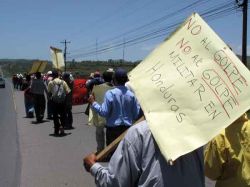 This represents the return of Zelaya but on the basis of a government of national unity with the coup plotters. His hands are tied.
This represents the return of Zelaya but on the basis of a government of national unity with the coup plotters. His hands are tied.
“3. Declaration of a general amnesty, exclusively for all those conflicts arising from the coup”
This means an amnesty only for the coup plotters, leaving the door open for Zelaya to be put on trial as the coup plotters pretend. His feet are also tied.
“4. President José Manuel Zelaya Rosales and his government renounce any attempt to have a fourth ballot box during the elections”
That is, the coup plotters achieve what they wanted with the coup, there will be no campaigning for a constituent assembly. Not happy with tying him hand and foot, Zelaya is also gagged.
“5. The bringing forward of the national elections scheduled for November 29 to the last Sunday in October.
“6. Transfer by the Armed Forces of executive power to the Supreme Electoral Tribunal one month before the elections in order to guarantee the transparency and normality of the suffrage.”
The elections are brought forward to be supervised by a body which is under the control of the oligarchy and which participated in the coup.
“7. The creation of a commission of verification made up of note-worthy Hondurans and members of international bodies, particularly the OAS, to look after the fulfilment of these agreements and to supervise the correct return to constitutional order”.
A commission of “note-worthy” Hondurans and “members of the OAS” to supervise that Zelaya, despite being tied foot and hand and gagged, does not attempt to do his own thing. Unfortunately Zelaya accepted all the points in this agreement, which represent a full scale capitulation, and he declared so publicly.
As well as getting a solution which would mean tying Zelaya foot and hand, another aim of these negotiations was to divert the attention of the national resistance against the coup away from mass mobilisation in the streets and to the negotiating table, where talks were being delayed for days and weeks. With a sharp political instinct, the leaders of the resistance maintained street protests and denounced the trap: “The social movements do not have many expectations in the talks that are taking place in Costa Rica; what they are doing is to win time for this de facto government so that they consolidate in power and break the resistance of the peoples’ movement”, said Juan Barahona, the leader of the Peoples’ Block.
The attitude of the National Front of Resistance Against the Coup was crystal clear from the beginning. First of all they said that mobilisations would not stop during the talks. Secondly they demanded as a basic point which could not be negotiated the restitution of president Zelaya. Thirdly, expressing the deep seated mistrust on the part of the organised people towards these talks, they demanded that representatives of the Front would be present in the talks and sent a delegation to Costa Rica. This is highly significant because it means that the National Front puts itself at the head of the organised people and assumes its representation in official forums, giving itself a similar rank to that of Zelaya’s legitimate government.
Finally, when the text of the San José proposal was announced, the Front, in an open letter to Oscar Arias, dated July 19, rejected all of the points in the text, with the exception of the first which talks about the restitution of the president. This shows the enormous maturity reached by the movement of the Honduras masses in the last few weeks of organised struggle against the coup. Also significant of the role acquired by the National Front is the fact that, on the first weekend in August, the US ambassador himself, Llorens, went to meet the leadership of the Front asking them to accept the San José proposal, which they strongly rejected.
However, the San José talks failed because of the refusal of the coup plotters to accept the first point, that is, the restitution of Zelaya. They correctly understood that the return of Zelaya, even bound hand and foot and gagged, in the context of mass mobilisations which continued unabated, would be seen as a victory for the movement. Zelaya himself could become a rallying point for the continuation of the mass struggle, regardless of the points of the agreement, and even regardless of his own will.
It is also clear that the coup regime feels safe and supported by the points of support they have in Washington, both within the Obama administration as well as amongst the Republican right. They know that Washington might exert some diplomatic pressure, but that it is not prepared to go all the way (that is, to cut off the supply of money and military aid or reach the point of direct intervention against the coup), because that would paramount to siding openly with Zelaya … and Chávez. They are bidding for time probably with the idea of reaching the elections in November or October which would give “democratic legitimacy” to the regime, and maybe reaching a stop gap solution in the form of a joint presidency or a third personality to occupy the position of president.
National resistance continues and is not cowed by repression
By expelling Zelaya from the country, the oligarchy achieved precisely what it wanted to prevent: it unleashed a mass movement of workers, peasants and youth which has grown in intensity and strength, in its degree of organisation, which repression has not been able to stop and which has drawn advanced political conclusions. The march on July 5th, when president Zelaya made an attempt to land at the Toncontin airport, was probably one of the largest that has ever taken place in the country’s history. This was one week after the coup. Even more extraordinary is the fact that the mobilisations and the strikes have continued for seven weeks, defying repression (which is increasing), the brutal misinformation campaign of all the media (with a few honourable exceptions) and all the diplomatic traps aimed at defusing the movement. We must pay tribute to the people of Honduras who, whatever the immediate outcome of this battle, have shown to have the necessary courage to fight heroically. It can be said that the Latin American revolutionary wave has finally reached the shores of Honduras.
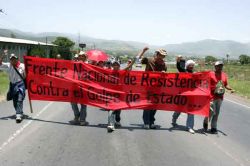 The mobilisations have been organised through the National Front of Resistance Against the Coup, which gathers all the trade union, peasant, youth, cultural, indigenous and political organisations in the country which oppose the Micheletti regime. The Front operates through weekly delegate assemblies where the next steps and the political line are discussed. The importance of this body is such that, as we have already mentioned, even the US ambassador has been forced to meet with its leadership. This proves that US imperialism is aware of the fact that any “solution” it wants to impose, must count on the approval of the Front.
The mobilisations have been organised through the National Front of Resistance Against the Coup, which gathers all the trade union, peasant, youth, cultural, indigenous and political organisations in the country which oppose the Micheletti regime. The Front operates through weekly delegate assemblies where the next steps and the political line are discussed. The importance of this body is such that, as we have already mentioned, even the US ambassador has been forced to meet with its leadership. This proves that US imperialism is aware of the fact that any “solution” it wants to impose, must count on the approval of the Front.
The trade unions have played a key role in the resistance against the coup. The strikes have affected above all the teachers, but also the rest of the public sector and sections of private industry. The Union of Beverage Workers (STIBYS) has become the nerve centre of the resistance and most of the delegate meetings of the Front are hold in its offices.
At the end of July, the coup regime of Micheletti was sure that the combination of the manoeuvres of San José, repression and misinformation, together with the understandable tiredness of a movement which had already been in the streets for a month, would have worn out the resistance and decided to lift the curfew. Big mistake. The national resistance responded with a national march on the capital Tegucigalpa and the second largest city in the country, San Pedro Sula, which started on August 6 and culminated in massive demonstrations on August 11. At the same time, the general strike which had been called every Thursday and Friday in the three precedent weeks, was extended on this occasion to the whole week. For five or six days, tens of thousands of Hondurans from all over the country, including the most remote peasant communities, marched by foot, 15 or 20 km a day, to show their opposition to the coup regime.
Repression increases
This impressive movement of the masses is taking place despite a clear increase of repression and the reappearance of the hated death squads. For instance, on Friday July 24, the police arrested Pedro Magdiel Muñoz Salvador, a 23 year old bricklayer. His dead body, which had 47 stab wounds, was found the following day, 400m away from the Nicaraguan border, where the Army was preventing Zelaya from entering the country. Clearly, either the police killed him or they handed him over to a paramilitary group to finish the job. Pedro Magdiel was an active member of the Front where he was part of the disciplinary commission.
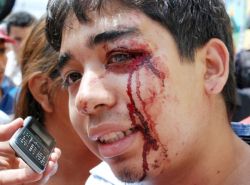 On July 2, the Army killed Gabriel Pino Noriega, a journalist from San Juan Puebla. On July 11, Roger Ivan Baez, a leader of the Peoples’ Block and the Democratic Unification (UD), former textile workers’ trade union leader, was killed when he entered his home in San Pedro Sula. On July 12, peasant leader Ramón Garcia, was taken off a bus and killed by armed men. He was also a member of the left wing Democratic Unification (UD) party. On July 30, teacher Roger Abrahan Vallejo Soriano, 38, was killed by the Army with a shot in the head. The list is long.
On July 2, the Army killed Gabriel Pino Noriega, a journalist from San Juan Puebla. On July 11, Roger Ivan Baez, a leader of the Peoples’ Block and the Democratic Unification (UD), former textile workers’ trade union leader, was killed when he entered his home in San Pedro Sula. On July 12, peasant leader Ramón Garcia, was taken off a bus and killed by armed men. He was also a member of the left wing Democratic Unification (UD) party. On July 30, teacher Roger Abrahan Vallejo Soriano, 38, was killed by the Army with a shot in the head. The list is long.
On July 26, the STIBYS union office, where the General Command of the Resistance Front meets, suffered a bomb attack. In the early hours of August 6, the building of the National Children’s Institute (PANI) was machine-gunned from a moving vehicle. The Union of PANI Workers (Sintrapani) has participated actively in the resistance and has an office in the building. On August 11, after dark, the offices of Via Campesina peasant’s organisation in the capital were also attacked with gun fire. It is important to stress that the majority of these attacks and selective murders take place at night once the curfew is in place, when only police and the army are allowed to be on the streets.
The students and teachers of the National Autonomous and National Pedagogic Universities have also suffered from repression and the police and the Army have, illegally, invaded their installations.
The regime has also resorted to the infiltration of agents provocateurs into the demonstrations of the resistance with the aim of causing violent incidents so that then they can present a picture of the demonstrators as a “violent mob”. This was the case at the end of the massive march on August 11, with the burning down of Popeye’s fast food restaurant and a number of public transport units, an action which was clearly organised by provocateurs in order to “justify” indiscriminate police repression. The final result was hundreds of people injured and at least 40 taken into custody. Amongst those wounded is Marvin Ponce, a member of parliament for the UD. The repression, carried out by the Army and the police, was brutal and was also used against the march in San Pedro Sula. Despite this, the movement was not cowed and protests continued on August 12, 13 and 14.
Which strategy for the movement?
The resistance movement has reached a turning point. On the one hand, the oligarchy is not able, neither with tricks nor with repression, to smash the resistance against the coup. The resistance on the other hand, led by the Front, has shown to have the ability to mobilise in large numbers and the people of Honduras have responded to all its calls, facing brutal repression. However, it has not yet been able to defeat the coup.
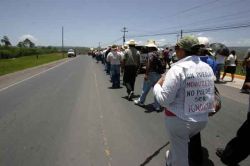 Which strategy can lead the movement to victory? First of all, the appeal by the Front and the unions which participate in it for a general strike is correct and necessary. The coup plotters represent the interests of 12 families which control the country’s economy (the Rosenthal, Ferrari, Canahuati Larach, Facussé, Nasser, Lamas, Kafie, etc). The country’s economy, already hit by the crisis, has been seriously affected by the coup and the mobilisations against it. The workers have the ability to completely paralyse the country’s economic and social life. Without the kind permission of the working class in Honduras, the transportation system would grind to a halt, education and health service would not work, the maquiladoras would be paralysed, papers could not be printed, electricity would not be generated and telecommunications would be stopped. The Front has already made an appeal to “spread the peaceful actions to paralyse the normal functioning of the commercial operations of those companies which promote, finance and execute the political and military coup against the legitimated government of Manuel Zelaya Rosales and against the people of Honduras as a whole”. It is necessary that this appeal is put into practice in the form of a complete general strike which puts on the table the question of who rules the country.
Which strategy can lead the movement to victory? First of all, the appeal by the Front and the unions which participate in it for a general strike is correct and necessary. The coup plotters represent the interests of 12 families which control the country’s economy (the Rosenthal, Ferrari, Canahuati Larach, Facussé, Nasser, Lamas, Kafie, etc). The country’s economy, already hit by the crisis, has been seriously affected by the coup and the mobilisations against it. The workers have the ability to completely paralyse the country’s economic and social life. Without the kind permission of the working class in Honduras, the transportation system would grind to a halt, education and health service would not work, the maquiladoras would be paralysed, papers could not be printed, electricity would not be generated and telecommunications would be stopped. The Front has already made an appeal to “spread the peaceful actions to paralyse the normal functioning of the commercial operations of those companies which promote, finance and execute the political and military coup against the legitimated government of Manuel Zelaya Rosales and against the people of Honduras as a whole”. It is necessary that this appeal is put into practice in the form of a complete general strike which puts on the table the question of who rules the country.
Secondly, the mass presence of the people on the streets must be maintained (with the necessary caution not to wear out the movement). As part of the strategy of mobilisation the question of how to deal with repression and infiltrated agents must be discussed. Correctly, the Front has based itself so far on peaceful mass mobilisations. However, faced with growing and brutal repression on the part of the coup regime, it is necessary and urgent to organise the self-defence of the resistance, of its mobilisations and of its organisations. In each trade union and peasant organisation self defence pickets must be organised to defend their offices and their leaders. These pickets must be under the strict control of the organisations and not act on their own initiative. In the same way, these pickets should play a key role during the marches, guarding them against the infiltration of provocateurs and if needed, organising the defence of the marches against the attacks by the police and the army. The danger is that if measures of this kind are not taken, there could be the temptation amongst sections of activists of the resistance, frustrated and impotent faced with repression, to organise small armed groups, isolated from the mass movement, which would be counter-productive.
Thirdly, on August 1, the Front made a correct appeal for an international workers’ boycott against the coup regime: “The National Front Against the Coup makes an appeal to the organisations which represent the world working class to organise and implement militant solidarity with the working class and the people of Honduras, by carrying out actions of boycott of all products which leave and enter Honduran ports, in order to economically asphyxiate the dictatorship”. Now it is the responsibility of all workers organisations in Central America to carry this appeal into practice. The workers of Guatemala, El Salvador, Nicaragua and Costa Rica have a particular responsibility in this. They hold in their hands the physical possibility to blockade Honduran international trade. They must understand that if the coup is finally victorious in Honduras, the oligarchy of their own countries would be strengthened and would feel confident to carry out actions on the same lines. The threat is real and very concrete in the case of El Salvador, where the FMLN won the elections but does not control parliament. For the worker and peasant masses of these countries, the defeat of the coup in Honduras is a question of life and death.
The trade union organisations in the US also have an important responsibility in this, as most of Honduras’ foreign trade takes place with the US. The US longshoremen have a proud and militant tradition of international solidarity and should declare immediately a workers’ boycott on all goods from and to Honduras.
Fourthly, it is important to understand that the coup regime will not fall unless the repressive apparatus of the state is broken. In the first days of the coup there were many isolated examples of rank and file elements within the Army and the police who were sympathetic to the people. There were even rumours of a possible rebellion of young officers. For the seven weeks of the resistance, the people, showing great instinct, have approached the soldiers once and again, telling them that they are also part of the people and that they should not attack their own people. This is correct, but it is not enough. The Front should organise a conscious and coordinated campaign towards the ranks of Army in order to break its morale. Leaflets specifically aimed at soldiers should be printed and distributed. They should be contacted through their families and neighbours. There should be an appeal for the formation of soldiers’ committees (which at first would necessarily have to be clandestine), which should be coordinated with the Front.
The combination of a general strike which would paralyse the country’s economic life, the mass mobilisation of workers, students and peasants on the streets, the international workers’ boycott and a serious and bold appeal to the ranks of the Army, is the only strategy which can guarantee a victory against the coup. Above all, the resistance can only trust its own forces. It is useless to make appeals to the US to intervene. As a matter of fact, diplomatic pressure on Micheletti will be stronger the stronger the movement of the masses is, since what the US and the bourgeois governments of Latin America and the EU fear the most is precisely the overthrow of the coup through an insurrectionary uprising of the people.
What programme?
Finally the question of the programme defended by the resistance is also vitally important if it is to gather around it the widest layers of the workers and the people. The Front has already made it clear that it is not just a question of the return of Zelaya, even though this is a basic democratic demand, but that their struggle is for the calling of a Constituent Assembly in order to turn the political institutions of the country upside-down. In the conditions of Honduras this demand is absolutely correct, together with that of trial and punishment for the coup plotters.
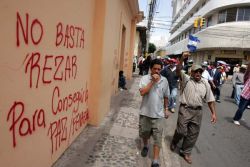 However, a constituent assembly in and of itself cannot solve the deep seated problems of the Honduran masses. In Venezuela, Bolivia and Ecuador Constituent Assemblies have been convened and new constitutions passed, but economic power remains in the hands of the oligarchy, and the bourgeois state is still in place blocking the advance of the revolution. It is not enough to change the political structures, the workers and peasants must take power, through committees of elected and recallable representatives, put an end to the farce of bourgeois democracy and replace it by a genuine form of democracy, workers’ democracy.
However, a constituent assembly in and of itself cannot solve the deep seated problems of the Honduran masses. In Venezuela, Bolivia and Ecuador Constituent Assemblies have been convened and new constitutions passed, but economic power remains in the hands of the oligarchy, and the bourgeois state is still in place blocking the advance of the revolution. It is not enough to change the political structures, the workers and peasants must take power, through committees of elected and recallable representatives, put an end to the farce of bourgeois democracy and replace it by a genuine form of democracy, workers’ democracy.
The most advanced democratic demands must be combined with the economic and social demands which are behind the struggle of the people of Honduras: for decent and secure jobs, for quality education for all, for free health care for all, for a agrarian reform, etc. All of this can only be achieved and guaranteed in a permanent way through expropriation of the 12 families which control Honduras in collaboration with and at the service of imperialism. Mel Zelaya himself pointed out during the solidarity meeting in Mexico on August 5 that the peoples of Latin America are struggling “to build a better world, free from the exploitation of a few which take advantage of the workers”. “The people of Honduras and the Latin American people are struggling for Socialism”, he added.
Even from a purely democratic point of view, this programme is logical. Is it not the 12 families that have carried out an undemocratic coup against the freely expressed will of the people? As a punishment, all their properties should be expropriated. The lessons of April 13, 2002, in Venezuela must be learnt, when after the defeat of the coup against Chavez by the masses no measures were taken against the coup plotters. How did they respond to this generosity on the part of the Bolivarian revolution? By organising another coup in December of the same year and sabotaging the economy up to this day.
It is the responsibility of the most advanced activists of the resistance and particularly those who come from a socialist tradition, like those of Democratic Unification, as well as long standing trade unionists, but also of the youth who are just now joining political life, to raise clearly the banner of the struggle for socialism as the only way out for the people of Honduras.
In the last seven weeks, the people of Honduras, and its working class at the forefront, have written a glorious page of struggle and resistance. The outcome of this battle is not yet decided. The International Marxist Tendency is unconditionally on the side of the resistance against the coup and we modestly want to contribute our opinions to the debate on the programme and the strategy that can make possible a victory against the oligarchy and imperialism.
